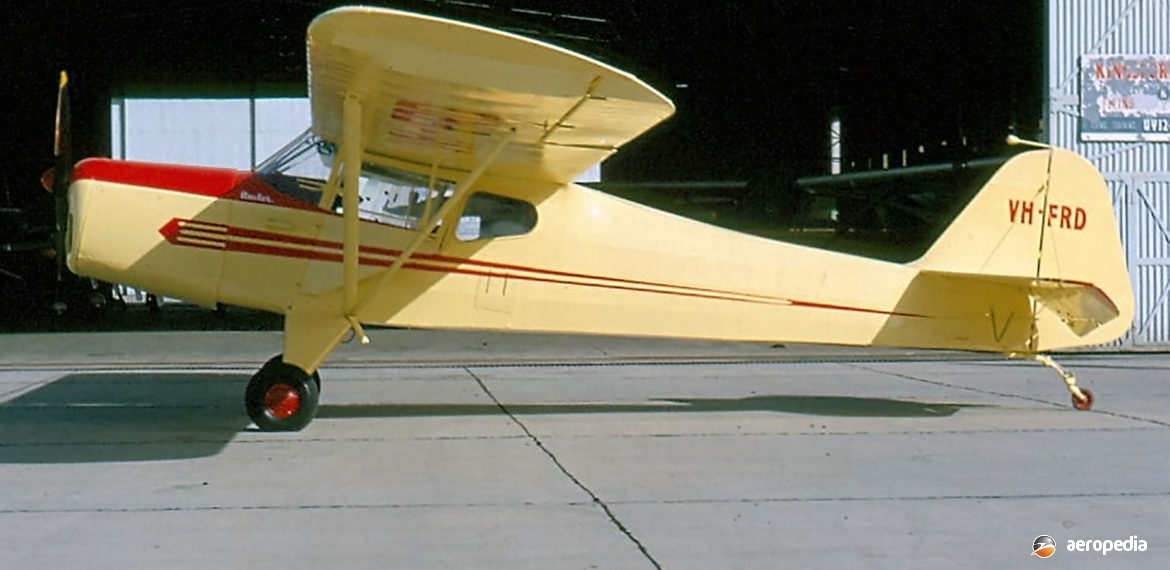Photograph:
Auster J-4 Archer VH-FRD (c/n 2068) at Bankstown, NSW (David C Eyre)
Country of origin:
United Kingdom
Description:
Two-seat touring monoplane
Power Plant:
One 67 kw (90 hp) Blackburn Cirrus Minor 1 four-cylinder in-line air-cooled engine
Specifications:
- Wingspan: 10.97 m (36 ft)
- Length: 7.16 m (23 ft 5¾ in)
- Height: 1.98 m (6 ft 6 in)
- Wing area: 17.2 m² (185 sq ft)
- Max speed: 174 km/h (108 mph)
- Cruising speed: 148 km/h (92 mph)
- Initial rate of climb: 227 m/min (746 ft/min)
- Range: 515 km (320 miles)
- Empty weight: 433 kg (955 lb)
- Loaded weight: 726 kg (1,600 lb)
History:
Because of import restrictions on American-built engines for some years after World War II, Auster Aircraft decided to fit a British-built engine, the Blackburn Cirrus Minor, to an Auster J-2 Arrow airframe. This became the prototype for the J-4 Archer series, making its first flight in 1946 and later becoming G-AIGZ. Only 26 J-4 Archer aircraft were built, and all were initially registered in the United Kingdom, many later being exported. They were not particularly popular on the market because they only had two-seats, whereas other Auster models, such as the J-1 Autocrat, had three. A further J-4 Archer was constructed at Rearsby in Leicester, UK from the major components of an Auster J-2 Arrow (G-AJPU) in 1958, production of the series having been completed in 1951.
Seven examples of the J-4 were imported to Australia by Kingsford Smith Aviation Service being assembled at Bankstown, NSW for sale. On the Australian market they became known as the J-4 Archer. Probably the most notable of the series was VH-AET (c/n 2072 – ex G-AIJP), which flew with the Rearsby Flying School before importation, and which, on 30 August 1955, whilst being hand-started at Bankstown, and whilst owned by Kingsford Smith Aviation Service, got away from the pilot and took off pilotless. It was subsequently followed by RAAF Gloster Meteor F-8s from Williamtown, NSW but they were unable to shoot the aircraft down, and it was eventually shot down off Palm Beach in Sydney, NSW by Hawker Sea Fury FB.11s of the Royal Australian Navy from ‘HMAS Albatross’ at Nowra, NSW. It is interesting to note another J-4 Archer G-AJYX took off in similar circumstances from Rearsby on 22 April 1951 and, after circling for two hours, ran out of fuel and crashed.
Examples of the J-4 Archer in this region, and the registrations they carried, were: VH-AAO/VH-KFC/VH-CDQ (c/n 2070) which crashed near Young, NSW on 22 July 1966; VH-AAL (c/n 2066) which crashed at Bankstown, NSW on 11 August 1955; VH-AAG/VH-FRD (c/n 2068) which crashed at Cape Barren Island off Tasmania on 10 July 1966; VH-AET (see above); VH-AAK/VH-PJN (c/n 2079) which was retired in December 1973; VH-AEA/VH-KFG/VH-CYR (c/n 2081) which crashed at Mulwala, NSW on 12 October 1961; and VH-AEC/VH-KFE/VH-CGD (c/n 2082 ) which crashed at Waterford, near Brisbane, QLD on 29 March 1968.
In addition three Auster J-2 Arrows were converted to J-4 Archer configuration by the installation of the Blackburn Cirrus Minor engine. These were: VH-BDE/VH-KFB/VH-CRR (c/n 2352); VH-BNQ/VH-KFF/VH-CGF (c/n 2361) retired in January 1975; and VH-ABF/VH-BYL (c/n 2389).
One J-4 Archer was registered in New Zealand as ZK-AXC (c/n 2080) which in 1997 was re-engined with a Lycoming O-320 engine.

